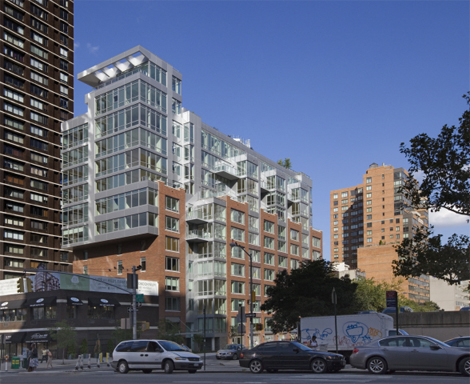International design and architecture firm Perkins Eastman announced that 303 East 33rd Street in Manhattan, NY, has achieved LEED 2.2 certification for New Construction.
The 165,000 sf 12-story residential building is the first green development to be LEED certified in the Murray Hill neighborhood of Manhattan.
With quality of life top of mind, the development team worked closely with the design team to deliver a building that is in keeping with the neighborhood's architectural diversity while also an example of a responsible, forward-thinking urban development.
Featuring a highly energy-efficient envelope that exceeds the thermal requirements of New York City code, the building appears as a series of single attached buildings that alternate in height. Large expanses of glass, terraces, and balconies further texture the building's facade, helping to bring in natural light throughout. A landscaped rooftop takes advantage of prime views of the city and provides outdoor gathering space for residents, landscaped with indigenous plants that require minimal potable water.
Using rapidly renewable materials and low-VOC finishes, Perkins Eastman created a contemporary interior space that engages the residents in a more sustainable lifestyle. Each unit is equipped with electrical sub-meters, allowing tenants to monitor their electrical use and manage their personal consumption. To discourage automobile use, the building purposely refrained from including a parking garage and instead chose to offer parking discounts in an adjacent venue for hybrid vehicles.
Prior to construction, environmental remediation of the entire site was performed. More than 63% of construction waste was diverted from landfill during construction due to the team's waste management program. BD+C
Related Stories
| Aug 11, 2010
Great Solutions: Healthcare
11. Operating Room-Integrated MRI will Help Neurosurgeons Get it Right the First Time A major limitation of traditional brain cancer surgery is the lack of scanning capability in the operating room. Neurosurgeons do their best to visually identify and remove the cancerous tissue, but only an MRI scan will confirm if the operation was a complete success or not.
| Aug 11, 2010
Great Solutions: Collaboration
9. HOK Takes Videoconferencing to A New Level with its Advanced Collaboration Rooms To help foster collaboration among its 2,212 employees while cutting travel time, expenses, and carbon emissions traveling between its 24 office locations, HOK is fitting out its major offices with prototype videoconferencing rooms that are like no other in the U.
| Aug 11, 2010
2009 Judging Panel
A Matthew H. Johnson, PE Associate Principal Simpson Gumpertz & HegerWaltham, Mass. B K. Nam Shiu, SE, PEVP Walker Restoration Consultants Elgin, Ill. C David P. Callan, PE, CEM, LEED APSVPEnvironmental Systems DesignChicago D Ken Osmun, PA, DBIA, LEED AP Group President, ConstructionWight & Company Darien, Ill.
| Aug 11, 2010
Inspiring Offices: Office Design That Drives Creativity
Office design has always been linked to productivity—how many workers can be reasonably squeezed into a given space—but why isn’t it more frequently linked to creativity? “In general, I don’t think enough people link the design of space to business outcome,” says Janice Linster, partner with the Minneapolis design firm Studio Hive.
| Aug 11, 2010
BIM school, green school: California's newest high-performance school
Nestled deep in the Napa Valley, the city of American Canyon is one of a number of new communities in Northern California that have experienced tremendous growth in the last five years. Located 42 miles northeast of San Francisco, American Canyon had a population of just over 9,000 in 2000; by 2008, that figure stood at 15,276, with 28% of the population under age 18.







